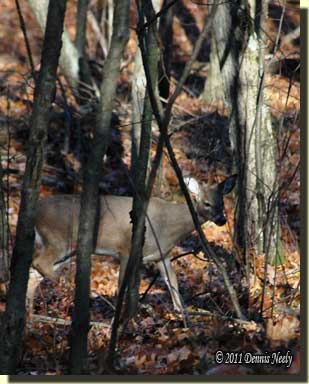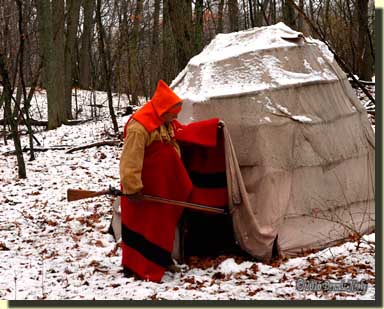Ears appeared first. An eye, a snout, a turn of the head came next. Two large oak trees and several fallen branches blocked the doe’s body from view. Two hoof-falls brought a head bob and a twitch of the ears as she looked to the east. Three steps, a sniff of the cold December air, then a short advance. With great care and deliberation this woodland creature progressed north along the trail that skirted the nasty thicket.
 The young doe glanced uphill once or twice, but she concentrated her caution on the far knoll. A large scrape remained open at the base of that soft rolling hill, but she showed no inkling to visit. From first discovery, her tail stretched straight back. The wind quartered against her left flank. She whiffed the sporadic breeze with regularity and a noticeable edginess.
The young doe glanced uphill once or twice, but she concentrated her caution on the far knoll. A large scrape remained open at the base of that soft rolling hill, but she showed no inkling to visit. From first discovery, her tail stretched straight back. The wind quartered against her left flank. She whiffed the sporadic breeze with regularity and a noticeable edginess.
Two white oak leaves fluttered to earth ahead of her. She gave them no mind. But from their descent Msko-waagosh, who rested against a thick red oak halfway up the slope, knew she was not far from detecting his deadly scent. She then melted away behind a tall wild cherry tree and a stout maple that did not grow near each other, but aligned by sight. A few steps later, the long white hairs of her rump, matted flat with green diarrhea, suggested a reason for her extreme caution.
The breeze ceased. The doe flicked her nose as she hit the returned white captive’s aroma. Four quick prancing steps and two bounds cleared the scent cone. She neither snorted nor spooked, but rather continued on as if danger did not offend her natural senses. In time she reached the rotting crown of the toppled hickory, the one that used to adorn the crest of the next rise.
Msko-waagosh, the Red Fox, pulled a blanket fold up higher on his cheek and turned his attention to the break in the trees where he first saw the young doe’s ears. His thumb fiddled with the jaw screw on the hammer of his Northwest trade gun as he rethought the whitetail’s approach and calculated where the best shot was in case a buck was on her trail.
Quite some time later, a large doe stepped around the scrape and plodded over the thin strip of ground that separated the two lobes of the nasty thicket. A smaller deer, about the size of the cautious doe, trailed two-dozen deer-paces behind. The pair bunched up about at the break in the trees—again, the point of sighting of the first doe.
The matriarch sniffed the trail to the north; her offspring walked up the slope, beyond the wall of trees, then stopped in the midst of the raspberry bushes. Eight or nine hoof-falls down the trail, the older doe tested the air, then looked across at the knoll. Her ears flipped front-to-back, then side-to-side. After a long pause, she turned westerly and took three steps uphill.
Both deer made their way up the slope, angling northwest. Their paths met not thirty paces upwind of the oak-tree lair. They paused. The savvy woodsman, schooled in his youth by the Ojibwe hunters of Ziibi Ikwe’s band, squinted his eyes as he breathed slow and steady into the blanket. The younger doe raised her snout high and tested the wind. Msko-waagosh smiled, knowing his secret was safe.
The older doe walked on with her head half-hung. The youngster followed. In no time at all the two traversed the hillside, passed over the crest and disappeared. They were the last whitetails encountered that cold December morn, east of the River Raisin, in the Old Northwest Territory.
An hour later, Msko-waagosh struggled to his feet. His leg muscles cramped and his back ached from sitting still so long in the cold wind. He stepped around the oak, avoiding the dead branches that lay scattered on the ground; some tented against the trunk. His thick moccasins eased west, imitating the young doe’s slow progression—he never took more than four steps without a deliberate pause.
In time he came to a small bump in the forest. His progress stopped at the large red oak. He leaned for several minutes, surveying the little bowl-shaped valley and studying the wigwam that sat between two downed oak tops. Satisfied all was well, the walked back to his 1796 hunting camp…
The Natural Aging of a Humble Wigwam
A hint of winter arrived a few days before this traditional black powder hunting adventure. On that Tuesday, the historical me encountered no deer. The highlight of the morning was returning to the woodland ambiance of a wigwam dusted with snow. The canvas was dry the day before. The big, fluffy flakes came overnight, and as the temperature rose, the snow began to melt. By late morning the canvas was damped on the sides and soaked on top.
 Unfortunately, this 1796 hunting camp has not lived up to expectations. Not that there is anything wrong with the shelter, but more so because life has thrown a bunch of curves this fall. Alas, family commitments and responsibilities come first, and living history trails a distant (you can read that as “non-existent”) second.
Unfortunately, this 1796 hunting camp has not lived up to expectations. Not that there is anything wrong with the shelter, but more so because life has thrown a bunch of curves this fall. Alas, family commitments and responsibilities come first, and living history trails a distant (you can read that as “non-existent”) second.
I logged only five days of hunting in November’s fifteen-day gun deer season. Small game season saw the same dismal participation rate. For the first time in the last twenty or so years, I did not purchase a waterfowl license, and the traps still hang in the old playhouse.
But as always, there is a silver lining to all adversity. In the case of the wigwam, the infrequent visits have accentuated my awareness of the structure’s aging process. Viewed on a day-to-day basis, the gradual degradation of the frame, lashings and cover might have gone unnoticed, but observed on a half-dozen visits spread over three months tells a different story.
On a number of occasions, I have written about the aging of clothing and accoutrements and the need to count the occasional hours of use, compared to the daily use sustained by the 18th-century hunter heroes. Thus, a normal hunting season of wear and tear for me, this year notwithstanding, spread over four-plus months equates to about three weeks in the life of John Tanner. It is a humbling thought when a living historian realizes fifteen years of hard hunting in his life equals one year in a revered woodsman’s life.
Each year I try to establish a period-correct shelter for my simple pursuits. I started the wigwam in October of 2015. This past May I re-applied the first row and finished the hanging of the canvas. The fabric is lower quality, cut from painter’s drop cloths, but I thought it satisfactory for the initial experiments.
Unlike my clothing and accoutrements, the wigwam’s aging is measured in real time, based on exposure to the elements day and night over seven months. The first change was the washed-out graying of the canvas from sun, rain and dew. Dust began accumulating on the bents and bows, then by mid-summer mildew started to grow on this “transient soil”—an unexpected happenstance.
While lying in the wigwam one September afternoon, Msko-waagosh discovered the first small holes in the covering. On closer inspection, it appeared an insect of some sort nibbled—again, not anticipated. Munch marks grew in number out into October, then a thumb-nail sized hole caught his attention, high up on the east side in the midst of a blackish mildew stain. My alter ego suspected this was the first sign of fabric rot, a circumstance he thought would not happen until 1798 at the earliest.
The day after the first snow had melted, the canvas was frozen stiff. The historical me, unfamiliar with such matters, wondered what effect a small campfire in the shelter would have on the canvas. Would it thaw? Would it give off small vapor trails as it dried? Would it make any difference? Time did not permit such a wilderness classroom lesson.
But the questions kept flowing; such is the plight of the living historian. Would the smoke from a daily fire waterproof the fabric? Would it keep the shelter dry and slow the aging process? Did the Ojibwe scrub the canvas when it started to mildew? Did they treat the fabric with anything to its life? How heavy was the canvas they used? How many prime pelts did it cost? How long did it last? Did they keep spare pieces to cover tears or repair calamities? And on, and on…
As responsibilities ease, I hope to venture back to the wigwam with Msko-waagosh on a regular basis. I feel a great loss, and at the same time, a burning desire to regain some of the memories that never were this fall. The original intent was to pull the canvas at the end of December in hopes of prolonging its life for another year. Now I am not so sure that is the best course, especially when I consider the door that has been opened by this fall’s adversity. I suspect there is a wealth of knowledge on the other side, knowledge that is not recorded in the pages of Tanner’s or Alder’s or Smith’s narratives. And all I have to do is step through times portal…
Give traditional black powder hunting a try, be safe and may God bless you.



2 Responses to Stepping Through Time’s Portal